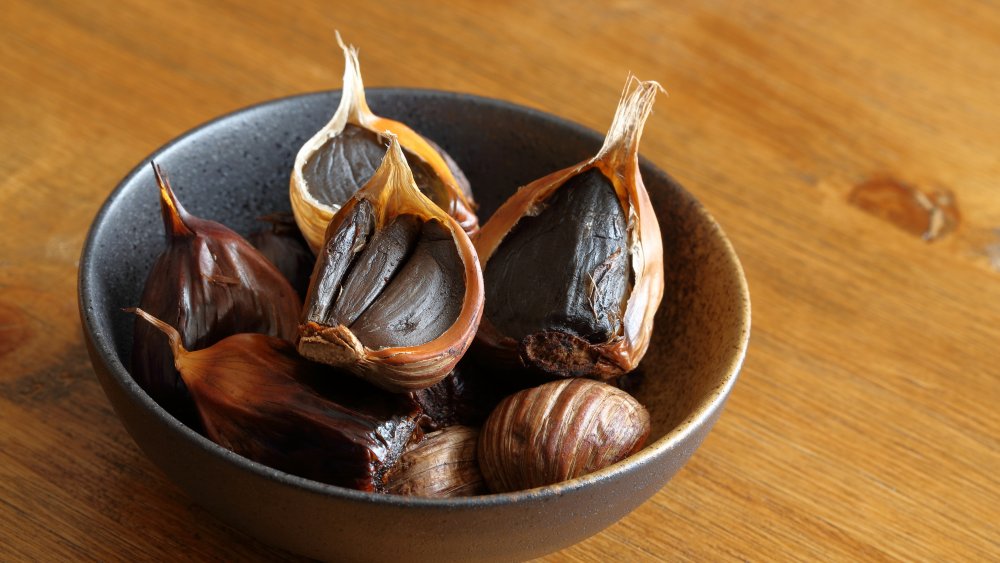Black garlic turns black after it is allowed to age over time under controlled conditions that bring about a Maillard reaction.
It is this chemical reaction between reducing sugars and amino acids that gives black garlic that dark color and distinctive flavor.
The flesh of black garlic has a flavor that is at once both distinctly savory and slightly sweet. The resultant flavor and texture is similar to that of molasses.
On the edges, black garlic feels tender yet dry, but the center is moist with a slightly gelatinous feel.
Black garlic has gained immense popularity over the last few years as a restaurant ingredient, although Asians have been eating it for centuries.
Black garlic is nutritious, rich in immune-boosting nutrients, such as phytonutrients, according to medical experts.
Dehydrators are a fairly popular tool for making home-made black garlic. But most people don’t own one. I don’t own one myself, either.
Most of the techniques I picked up from YouTube videos required me to make a ton of black garlic heads at a go. It was always too much for me to possibly consume at once, even with my garlic habit.
I was desperate to find a way to make just a few black garlic heads and without having to splurge on new kitchen equipment.
Instant Pot Black Garlic
When I discovered the Instant Pot technique, I was smitten with it. Of course I was enamored by the idea of making black garlic within a day instead of a month.
It was a YouTube video of course that came to my rescue. I learned that I could place peeled cloves of garlic inside a Mason jar, add the jar and a cup of water inside the Instant Pot, and then leave it cooking on high for the next 6-8 hours.
Six hours later, I was opened the Instant Pot to find somewhat sooty but not quite black garlic. The insides were just the same as those of raw garlic and not squishy at all.
At first I thought it was the six hour cooking time, so I tried again. This time I gave it the full eight hours. Even then, the texture was not soft and gelatinous like I wanted. The flavor too was a definite miss. Nothing like the black garlic I got from the store.
At this point, I was ready to move on to my next experiment: Slow Cooker Black Garlic.
Slow Cooker Black Garlic
Emerged from my failed experiment older and wiser, I went back to good old YouTube for inspiration for my next experiment. After a whole lot of YouTubing, I gathered that I was supposed to place the garlic heads inside a turkey basting bag and cooking it on low heat on the slow cooker and then leaving it for a week, checking on it, then cooking it for another week before my black garlic is ready.
It is a miracle that I even finished the first week of the damned experiment. By day three, the smell of garlic was so intense that I had to quarantine the slow cooker in the bathroom to avoid permanently marking my home with an indelible smell of garlic.
At the end of the week, the poor basting bag was melted, and the garlic was transformed into coal. Completely charred and lacking in moisture. To call it a failure would be an understatement.
I tested the temperature of the Crock-Pot after the whole thing was over and at was 350°F at the lowest setting. The failure of the experiment was no longer a mystery.
I decided to restart the experiment, this time turning it off and on to keep the temperature from going too high or too low.
It took effort to do this, and three days later, I was rewarded with a second batch of charred garlic.
My final conclusion was that this method only works with a slow cooker whose lowest temperature setting is between 120 and 160°F.
I was now about to give up, but I still had not tried my rice cooker. So off I went.
Rice Cooker Black Garlic
I approached my third and final experiment armed with the lessons learned from my work with the slow cooker.
I tested my rice cooker’s temperature first before putting in my garlic cloves. I was working with a trusted 15-year-old rice cooker. My Zojirushi rice cooker bottoms out at 150°F which is higher than 120°F but certainly not as high as 350°F. I would have to carry out a daily temperature check.
I started with two heads of garlic which I wrapped in foil before dunking into the rice cooker. The rice cooker was also sealed in foil from the top to keep the garlic from losing moisture.
Two days later, I checked on my garlic heads and loved how well they were doing. They were visibly darker, though not as dark as they needed to be. I did sadly, cause the garlic to lose much of its moisture.
By the sixth day, my garlic was almost black and thankfully not as dry as I expected. Day nine was the D-Day. I removed my garlic heads, skinned them and was delighted to discover a proper clove of black garlic.
The first thing I noticed was the aroma which was very similar to store-bought garlic. Then I cut it in two and discovered a gelatinous but stable texture. It was just what I wanted.
It was now time for the taste test. I now tasted the garlic and discovered that it was almost perfect. The ‘almost’ meaning that it was a little too dry.
I figure if I keep them covered throughout the cooking process and pull them out on Day 8 instead of Day 9, I will probably end up with perfect black garlic cloves.
I had achieved what I wanted. I had a reasonably sized batch of homemade black garlic ready without having to wait a whole two weeks or purchase any additional kitchen equipment.
My trusted old rice cooker was good enough. My two prior experiments were more than worth it. The milder flavors were pleasant. This method for preparing the best homemade garlic is perfect for black garlic lovers. People who rarely use black garlic can settle for store-bought garlic.


 Tips & Advice4 years ago
Tips & Advice4 years ago
 News & Stories3 years ago
News & Stories3 years ago
 Restaurants3 years ago
Restaurants3 years ago
 Recipes3 years ago
Recipes3 years ago
 Kitchen Gadgets3 years ago
Kitchen Gadgets3 years ago
 Kitchen Gadgets3 years ago
Kitchen Gadgets3 years ago
 Kitchen Gadgets3 years ago
Kitchen Gadgets3 years ago
 Chefs4 years ago
Chefs4 years ago





